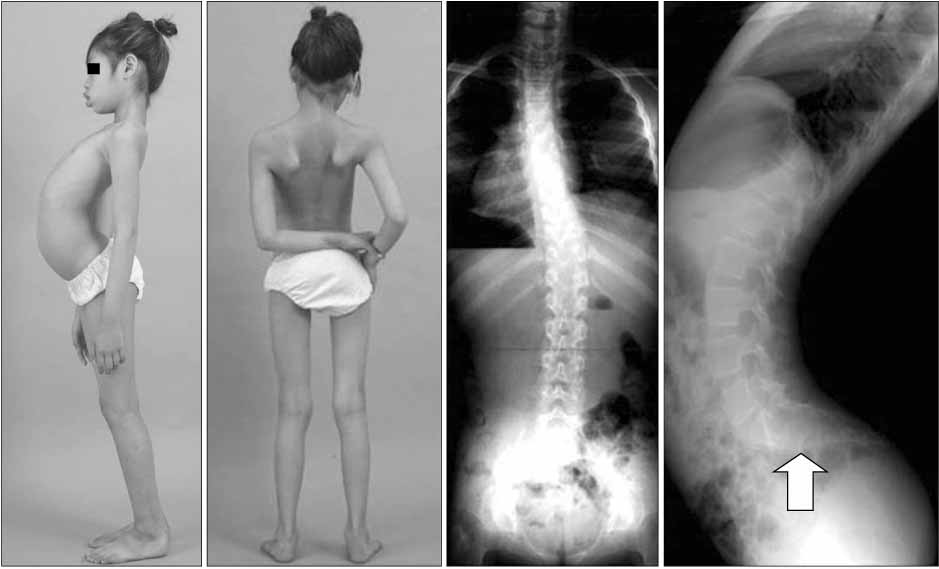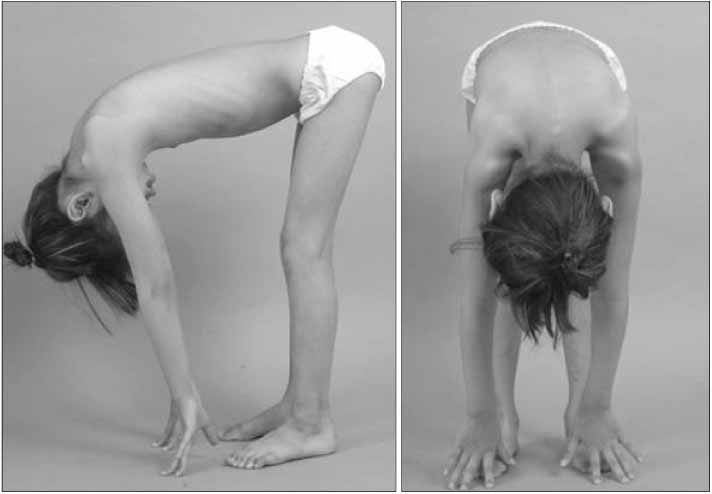J Korean Orthop Assoc.
2008 Jun;43(3):379-384. 10.4055/jkoa.2008.43.3.379.
Early-Onset Facioscapulohumeral Muscular Dystrophy: Significance of Pelvic Extensor in Sagittal Spinal Imbalance
- Affiliations
-
- 1Department of Orthopaedic Surgery, Asan Medical Center, College of Medicine, University of Ulsan, Seoul, Korea. cslee@amc.seoul.kr
- 2Department of Orthopaedic Surgery, Pusan Paik Hospital, College of Medicine, Inje University, Pusan, Korea.
- 3Department of Orthopaedic Surgery, National Police Hospital, Seoul, Korea.
- KMID: 2186456
- DOI: http://doi.org/10.4055/jkoa.2008.43.3.379
Abstract
- An 11-year-old girl with early-onset facioscapulohumeral muscular dystrophy (FSHD) presented with progressive gait disturbance and lumbar hyperlordosis. The motor power of her pelvic extensor muscles was grade 3. Pelvic tilt and hip flexion were markedly increased as determined by gait analysis. This FSHD case is an impressive example of a patient demonstrating the concept that weak pelvic extensor muscles cannot keep the spine upright and balanced. The most important factor in the development of hyperlordosis is the weakness of the pelvic extensor muscles, and the results of gait analysis exquisitely explain the pathophysiology. The patient stands with her spine hyperextended to maintain upright posture by a compensatory mechanism of relatively strong back extensor muscles. Corrective surgery for lumbar hyperlordosis was not considered as it could eliminate the compensatory lumbar hyperextension, thus making the spine of the patient stoop forward through the hip joint during walking, being caused by the weakness of her pelvic extensor muscles.
Keyword
MeSH Terms
Figure
Reference
-
1. Brooke MH. Clinical examination of patients with neuromuscular disease. Adv Neurol. 1977. 17:25–39.2. Brouwer OF, Padberg GW, Wijmenga C, Frants RR. Facioscapulohumeral muscular dystrophy in early childhood. Arch Neurol. 1994. 51:387–394.
Article3. Dorobek M, Kabzinska D. A severe case of facioscapulohumeral muscular dystrophy (FSHD) with some uncommon clinical features and a short 4q35 fragment. Eur J Paediatr Neurol. 2004. 8:313–316.
Article4. Felice KJ, Jones JM, Conway SR. Facioscapulohumeral dystrophy presenting as infantile facial diplegia and late-onset limb-girdle myopathy in members of the same family. Muscle Nerve. 2005. 32:368–372.
Article5. Lee CS, Lee CK, Kim YT, Hong YM, Yoo JH. Dynamic sagittal imbalance of the spine in degenerative flat back: significance of pelvic tilt in surgical treatment. Spine. 2001. 26:2029–2035.6. Miura K, Kumagai T, Matsumoto A, et al. Two cases of chromosome 4q35-linked early onset facioscapulohumeral muscular dystrophy with mental retardation and epilepsy. Neuropediatrics. 1998. 29:239–241.
Article7. Padberg GW, Lunt PW, Koch M, Fardeau M. Diagnostic criteria for facioscapulohumeral muscular dystrophy. Neuromusc Disord. 1991. 1:231–234.
Article8. Shapiro F, Specht L, Korf BR. Locomotor problems in infantile facioscapulohumeral muscular dystrophy. Retrospective study of 9 patients. Acta Orthop Scand. 1991. 62:367–371.
Article9. Song EW, Lenke LG, Schoenecker PL. Isolated thoracolumbar and lumbar hyperlordosis in a patient with cerebral palsy. J Spinal Disord. 2000. 13:455–460.
Article10. Vialle R, Khouri N, Guillaumat M. Lumbar hyperlordosis in cerebral palsy: anatomic analysis and surgical strategy for correction. Childs Nerv Syst. 2005. 22:704–709.
- Full Text Links
- Actions
-
Cited
- CITED
-
- Close
- Share
- Similar articles
-
- Facioscapulohumeral muscular dystrophy: report of two cases
- Facioscapulohumeral Muscular Dystrophy Confirmedby D4Z4 Analysis
- Shoulder Motion after Scapulothoracic Arthrodesis of the Facioscapulohumeral Type of Progressive Muscular Dystrophy ( PMD )
- A Family of Facioscapulohumeral Muscular Dystrophy
- Extensive inflammatory reaction in facioscapulohumeral muscular dystrophy






